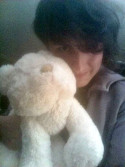Something I’ve struggled with is finding language and concepts that feel right and fit our plural experience. Though our “diagnosis” (better stated as “professional validation”) doesn’t differentiate between OSDD and DID, I have always identified more with OSDD experience. OSDD is “otherwise specified dissociative disorder” and is often used to describe a form of plurality that is like “dissociative identity disorder” (DID), but doesn’t fully meet the criteria for amnesia and/or distinctness between parts (identities or alters). We identify with both these differences; we have more shared memory and less day-to-day amnesia, and often have less distinctness between parts.
Relatedly, “median” is a term defined by plural community that refers to experiences somewhere between “multiple” (a system of more than one identity/alter in a single body), and “singlet” (a single identity in a body). Median shares something with OSDD; it involves less distinctness between parts or more shared aspects. It is not the same as OSDD, though, as it is a community-defined term which may evolve differently from OSDD in the DSM, and may include experiences of being multiple (not median) when parts identify as separate people or identities, but share memory.
In our experience, amnesia and distinctness can also be related. Though switching often involves the feeling of waking up from a dream (the dream being of the previous fronter’s activities), we still remember that dream well and do not experience significant difficulties arising from amnesia between us. As such, the sense that we are separate is less. Since we have some memory of what the previous fronter was doing, we experience a continuity of existence from one part to another that creates a greater feeling of connection between us. Despite this connection, however, not everyone in our system identifies as “median” with each other. Some connections still feel separate enough to create independent identities, while other connections feel more fluid and connected. An identity can be median with one part, and multiple (separate) with another.
Frequent blending is another way in which we experience less distinctness. For example, we have had times when one normally distinct part was upset about an issue another part was experiencing as if it was their issue, despite them not being involved. At other times there is no blending and we are each very much on our own, with the traits, issues, and memories of others not affecting us.
DID and plural community uses language and concepts that emphasize and validate the individuality and distinctness of each part. This validation is important, especially as we face misunderstanding from those around us. This includes invalidation from mental health professionals that might consider our plurality to be a delusion or attention-seeking, or who emphasize that each part cannot be a complete individual person. These beliefs run country to the experience of many plural systems, even those (including ourselves) in the OSDD category. I have done considerable mental backflips in an attempt to reconcile these ideas with our own experiences, but always come back to our experiences and individual identities being valid.
With this said, however, our experiences as an OSDD system sometimes grate against the language and concepts used by DID and plural community that emphasize individuality at the expense of recognizing the ways and degrees in which our parts are connected. This has lead to feelings of being stuck between two worlds: one in which I am an individual (where my experiences of being different people are somehow wrong), and another in which we are multiple (with the ways in which we are connected, and what we share between parts, feeling out of place). We don’t feel legitimate in either world, sometimes feeling that “we’ve even messed up being messed up”.
Just as DID and plural community have come together and evolved language and concepts to validate their experiences, I believe the same must be done by OSDD and median systems (who may be considered a plural subcommunity). Personally, there are some words, phrases, and concepts that I am comfortable with from DID and plural community. For example, I am comfortable using “we” and recognizing that we are a system of multiple individuals and fragments. But I also want to use terms and concepts that refer to and validate how our parts are connected. For example, a few of our parts now function as a single individual with identity fluidity between them. In this case I am more comfortable using “I” to refer to my other “co-part” even though we have a past history of greater separateness. I also like referring to others as “who I am when I’m not me” or “me when I’m not me”. These phrases validate both our separateness (“not me”) and connectedness (“who I am”). They also explain our experience as a single being that switches between multiple identities (more common for us), rather than multiple beings that can exist at the same time (less common for us). Instead of feeling stuck between worlds, this language has helped us better accept and navigate our system. Without these and other median and OSDD concepts, we tried to force ourselves into a strict DID, multiple or singlet model, none of of which were entirely helpful or appropriate.
Ultimately, it is not up to one person or system to define the language OSDD and median subcommunity might share. But I am hoping we can work together to create space for this subcommunity to feel valid in our own unique experiences, authentic in creating language and concepts for ourselves, and confident in communicating our experiences to others.

